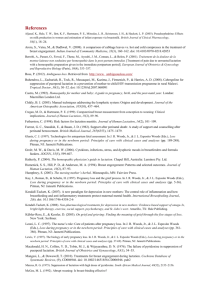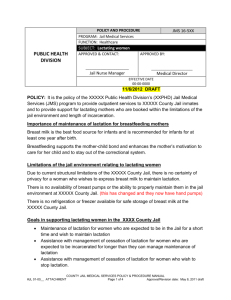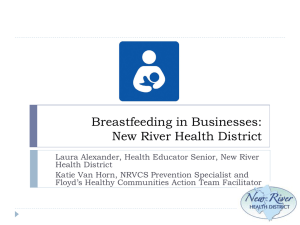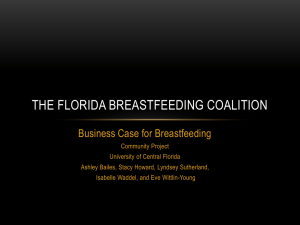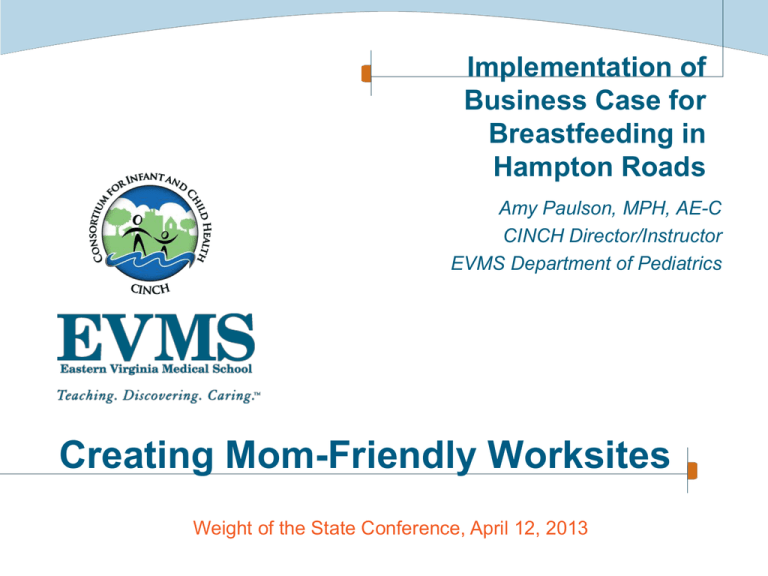
Implementation of
Business Case for
Breastfeeding in
Hampton Roads
Amy Paulson, MPH, AE-C
CINCH Director/Instructor
EVMS Department of Pediatrics
Creating Mom-Friendly Worksites
Weight of the State Conference, April 12, 2013
Consortium for Infant and Child Health
(CINCH)
Child health coalition with 200+ members serving Hampton
Roads, VA
EVMS is CINCH’s lead agency
Mission: Engaging the community to improve children’s health
in Hampton Roads
Focus: Obesity, Respiratory Health, Access to Care, Healthy
Communities
Approach: Policy, Systems, Environmental Change
Learning Objectives
1.
2.
3.
4.
Identify four components of comprehensive worksite
lactation support programs
Identify three approaches to employers regarding
establishing lactation support programs for employees.
List at least three factors businesses must consider in
establishing lactation support programs for employees
Introduce a mechanism to evaluate a community level
BC4BF project
Business Case for Breastfeeding Project
Primary Goal: Implement worksite lactation support
programs with at least 10 employers in South Hampton
Roads, Virginia (VDH funding for one year)
Evaluate organizational changes
Coalition building for breastfeeding promotion
Community Dialogues on breastfeeding & working
Use Business Case for Breastfeeding Toolkit
Components: Private Space, Flexible Breaks,
Education and Support
September 2010 - October 2011 & July 2012 - present
Worksite Lactation Support Program
Components
Private Space
Flexible Breaks
Education
Support
Outreach Approaches
1.
2.
3.
4.
Target mid-size to large employers of women
of childbearing age
Recruit participation of ‘partner’ organizations
first (i.e., “low hanging fruit”)
Direct contact by phone, email, in person
Healthcare Reform seminars, Workplace
Wellness conference
Implementation Approaches
1.
2.
3.
4.
In-person consultation & site visit at
workplace to introduce BC4BF toolkit &
Project
Lactation Assessment Form
Free technical assistance
Eligibility criteria for limited-time Incentives
Eligibility Criteria for Incentives
1.
2.
3.
4.
5.
6.
Lactation Program Assessment
Lactation Support Policy
Designated Lactation Area
Procedures
Company-wide Promotion
Employer Spotlight
The “Sell” - Benefits to Business
Compliance with FLSA
Wellness Initiative
increased productivity
decreased absenteeism
improved staff morale
cost savings
Competitive Employee Benefit
Community Role Model
Human Resources
Considerations
Accommodating flexible breaks and addressing
‘extra’ time needed in policies
Identifying private spaces & access options
Options for room furnishings and equipment
maintenance
Promoting the Lactation Support Program with new
and existing employees
Long-term sustainability
Policy Example:
REST PERIODS, MEAL PERIODS AND BREAKS FOR NURSING MOTHERS
C. Break Time for Nursing Mothers.
1.
In accordance with the Fair Labor Standards Act (FLSA), EVMS
provides employees who have need to express breast milk with
the following:
a. Two 15 minute paid breaks for every four hours of working time,
which would replace any other paid break time normally granted
during the employee’s shift. For those employees scheduled to
work a shift in excess of 8 hours, one additional paid 15 minute
break may be provided;
b. Any additional unpaid breaks as needed to express breast milk
(employees must clock out when using unpaid time); and
Policy Example, cont.
2.
3.
4.
c. A private location, other than a bathroom, to express breast milk
upon written request to Human Resources. Please contact Human
Resources for the location of your Department’s lactation space or
more information.
Employees intending to express breast milk at work must notify
their immediate supervisor, each shift, and schedule breaks to
express milk to best accommodate the employee and the
Department workflow.
Breaks for nursing mothers will be provided for up to one year
after the birth of a child.
Expressed breast milk must be stored in personal coolers.
Lactation Rooms and Signage:
Educational Institution Setting
Lactation Rooms and Signage:
Educational Institution Setting
Lactation Room: Hospital Setting
Before
After
Lactation Room – Military Setting
Before
After
Implications for Implementing
Health Reform
•
•
•
•
•
Implementation support useful for large and small employers
Interest from an external catalyst can accelerate internal
compliance & advance comprehensiveness of LSP
Employers gain LSP expertise quickly with BC4BF Toolkit
resources
Importance of flexibility and adaptation as no two situations are
identical, even within a large parent organization (e.g. hospital
system)
Emphasize WIN-WIN-WIN: Healthier babies, employees,
business bottom line
Challenges
Competing demands – low priority
Contentment with status quo
Eligibility Criteria too demanding?
Brief project timeframe
Identifying an effective champion
Additional policy/protocol needed for room & pump
management (i.e., cleaning, storage, maintenance)
Successes
•
•
•
•
•
•
•
17 businesses were at least minimally engaged
16 participated in face-to-face consultations
15 completed baseline Lactation Assessment Form
14 made implementation progress during project
timeframe
13 affected by 8 drafted/adopted policies
14 created/upgraded 17 lactation rooms
Over 6,200 women impacted across worksites
Evaluation Challenges
•
•
Short term project
Not research
•
•
•
•
Scientific rigor limited
IRB – Determination of non-research
Use of incentives helped motivate protocol compliance
Lactation Assessment Form set-up and completion
•
•
•
Piloting – was useful for e-format
Timeliness – not all completed at most optimal start time
No formal post-test
Lactation Assessment Form (LAF)
General information about business/worksite
Human Resources
e.g. # women of childbearing age, pregnancy and
breastfeeding rates, absenteeism, etc.
Company Policies
e.g. type, size, role of respondent
e.g. general lactation support, leave, return to work,
insurance coverage
Lactation Program Components
e.g. Infrastructure, breastfeeding options, funding,
resources, etc.
The Businesses/Employers
Lactation Program Assessment Descriptive Results
Business Size
n = 15
Small (1-99 employees)
3
Mid-sized (100-499 employees)
4
Large (500 or more employees)
8
%
20%
27%
53%
Estimated Potential Impact
Count
Range
Female Employees, age 16-44
Male Employees age 16-44
New Babies - Annual Estimate
>4,61915 to 842
1,353 3 to 233
213 1 to 50
The Businesses/Employers
Lactation Program Assessment Descriptive Results
Policy and Insurance Items
Count Percent
Lactation Policy Status
No Previously Existing Policy
8
53%
Previously Existing Policy
7
47%
11
73%
13
87%
2
13%
Unwritten and/or Unofficial
Maternity Leave Policy
FMLA
Disability Insurance
The Businesses/Employers
Breast Pump Equipment Employees Receive Count %
None, employees use their own
9
Purchased hospital-grade electric pump
1
Rented hospital-grade electric pump
1
Portable pumps
0
Other
3
Unknown
1
Breast Milk Storage
Employee provided cooler
11
Company provided cooler
0
Small designated refrigerator
3
Public shared refrigerator
7
Other
2
60%
7%
7%
0%
20%
7%
73%
0%
20%
47%
13%
Evaluation Measures – Likert-Type Scales
1.
2.
3.
4.
5.
6.
Level of Engagement with the Project
Stage of Change – TransTheoretical Model of
Behavior Change adapted for organizations
Comprehensiveness of Lactation Support
Program Components
Level of Policy Development
Changes in Physical Environment
Changes in Social Environment
BC4BF Evaluation Ratings
Engagement (E) of businesses/employers with
BC4BF Project
Minimal
= 1: intention, support letter, BC4BF training
Engagement = 2: onsite consult, lactation area analysis
Moderate = 3: commitment to enhance LSP, LAF
completed
High = 4: written policy, equipped lactation area,
procedures, promotion
BC4BF Evaluation Ratings
Stage of Organizational Change (TTM)
Precontemplation
= 1: non-issue
Contemplation = 2: awareness, FLSA compliance, value
as family support, considering feasibility
Preparation = 3: exploring issue, timeline, info gathering
Action = 4: facilities, policy, champions, signage, promo
Maintenance = 5: ongoing champion, eval & monitoring,
integration into way of doing business
BC4BF Evaluation Ratings
Implementation/Level of Comprehensiveness of
Lactation Support Program (Comp)
Unsatisfactory:
No Lactation Support = 1
Satisfactory: Basic Model (2 required items) = 2: breaks
and non-restroom space; plus privacy, locks, chair,
pump, table; and flexible break scheduling
Superior: Basic Model plus (3 or more items) = 3: written
policy, education, peer support, enhanced (baby onsite,
paid breaks, footstool, recliner, fridge, etc.)
BC4BF Evaluation Ratings
Policy (P): CHANGE Rating
Not
Identified as a problem = 1
Problem identification gaining agenda status = 2
Policy formulation and adoption = 3
Written policy and implementation = 4
Policy evaluation and enforcement = 5
BC4BF Evaluation Ratings
Physical Environment (PE): CHANGE Rating
No
elements in place = 1
Few elements in place = 2
Some elements in place = 3
Most elements in place = 4
All elements in place = 5
BC4BF Evaluation Ratings
Social Environment (SE): CHANGE Rating
No
support or negative support in place = 1
Neutral or some support emerging = 2
Positive support, some encouragement for using
BF facilities = 3
Active support, absence of criticism = 4
Enthusiastic support communicated = 5
Results: Baseline and Post Intervention
Comparison of Means, p = < 0.0001
4.5
4
3.94
4
3.65
3.94
3.53
3.5
Baseline
2.88
3
2.53
2.5
2
1.76
1.71
1.5
PostIntervention
1.59
1.29
1
1
0.5
0
(E)
(TTM)
(Comp)
(P)
(PE)
(SE)
Case Example: EVMS
Large Employer - > 500
580 women aged 16 – 44, 233 males
Estimated 50 annual pregnancies
Breastfeeding rates unknown
No lactation support policy at baseline, new policy needed
Provides FMLA and disability
Health insurance provides “Expectant Mother” programs
Employee health unit domain
Personal office available
$500 start up available
Employees’ own pump/cooler pack
Newsletter and website
Case Example, EVMS: Evolution Pre - Post
Baseline
Post Intervention
5
5
4
5
4
3
2
2
1
1
Engage
SOC
1
Comp
SocialEnv
1
Policy
PhysEnv
Case Example: EVMS
Established 5 lactation rooms
Plans to establish more rooms in all buildings
on campus
Next Steps
Seek financial support to continue promotion,
coordination and technical assistance
Outreach to more businesses
Expand coalition component
Expand support for parents
Promote breastfeeding-friendly community
Monitor health impacts
Publicity and BIB awards (Business Investment in
Babies)
Acknowledgments
•
•
•
•
•
•
•
•
•
Elise Wallace, MPH – Project Manager
Cheza Garvin, PhD – Evaluation Director
Natasha Sriraman, MD, MPH, IBCLC – Medical Director
Liz Flight, RN, IBCLC – Informal Consultant
Liz Marshall, MPH – Volunteer
Business Partners
Employer Champions
Professional groups and coalitions
Other Volunteers & Staff support
Support
•
Virginia Department of Health’s CHAMPION Program
(Commonwealth’s Healthy Approach and Mobilization
Plan for Inactivity, Obesity and Nutrition)
•
American Recovery & Reinvestment Act (ARRA)
Communities Putting Prevention to Work
•
Eastern Virginia Medical School
•
National Association of Chronic Disease Directors/CDC
Action Communities for Health, Innovation and
Environmental Change Grant (ACHIEVE)
Resources
•
•
•
•
Business Case for Breastfeeding:
http://www.womenshealth.gov/breastfeeding/governmentin-action/business-case-for-breastfeeding/
Fact Sheet #73: Break Time for Nursing Mothers under the
FLSA :
http://www.dol.gov/whd/regs/compliance/whdfs73.htm
AIA Lactation Room Design form:
http://www.aia.org/aiaucmp/groups/ek_public/documents/p
df/aiap037226.pdf
Sample policy development guide:
http://www.cdph.ca.gov/programs/breastfeeding/Document
s/MO-BF-WorkPolicy.pdf
Thank you
Questions?
Amy Paulson, MPH, AE-C
757-668-6426
CINCH@evms.edu
www.cinchcoalition.org
www.facebook.com/cinchcoalition
Twitter @CINCHCoalition
www.facebook.com/healthyhr


